Marketing Consumer Behaviour: BMW Environmental Scan Analysis Report
VerifiedAdded on 2023/06/10
|9
|2386
|327
Report
AI Summary
This report provides a comprehensive environmental scan of BMW, a leading luxury car manufacturer. It examines the political, economic, social, technological, demographic, and competitive factors impacting BMW's operations and market performance. The analysis delves into political and legal factors such as CO2 emission regulations and tax implications, economic influences like exchange rates and consumer purchasing power, and social factors including changing consumer preferences towards fuel-efficient vehicles. Technological advancements and competitive pressures from brands like Audi and Mercedes-Benz are also assessed. The report highlights how BMW adapts to demographic trends and consumer behavior to maintain its market position. The study also includes an analysis of the brand's target market and its current integrated marketing communication (IMC) campaign, evaluating the effectiveness of various IMC tools in creating a positive brand attitude, as well as the internal and external factors affecting consumer choice. This detailed environmental scan aims to provide valuable insights into BMW's strategic approach within the dynamic automotive industry.
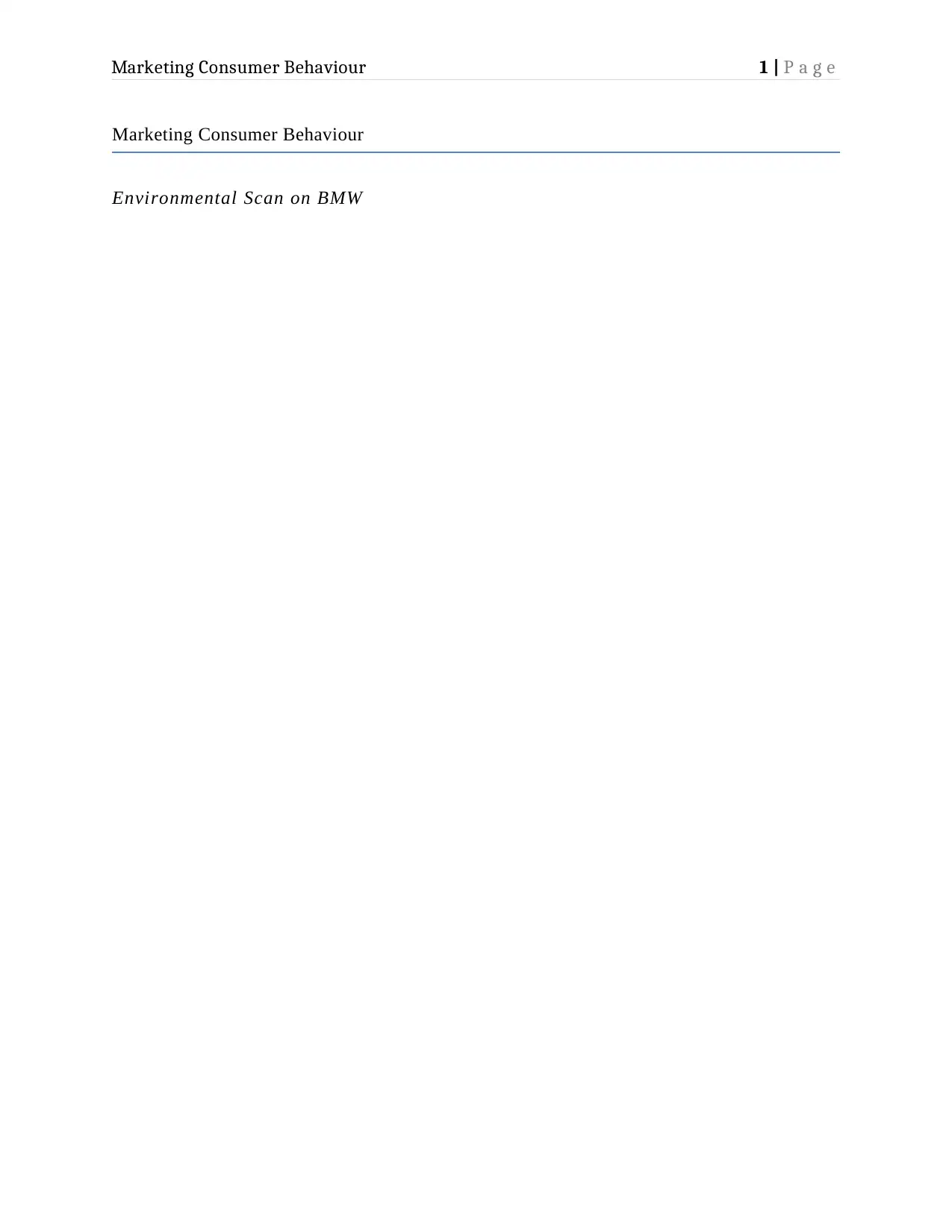
Marketing Consumer Behaviour 1 | P a g e
Marketing Consumer Behaviour
Environmental Scan on BMW
Marketing Consumer Behaviour
Environmental Scan on BMW
Paraphrase This Document
Need a fresh take? Get an instant paraphrase of this document with our AI Paraphraser
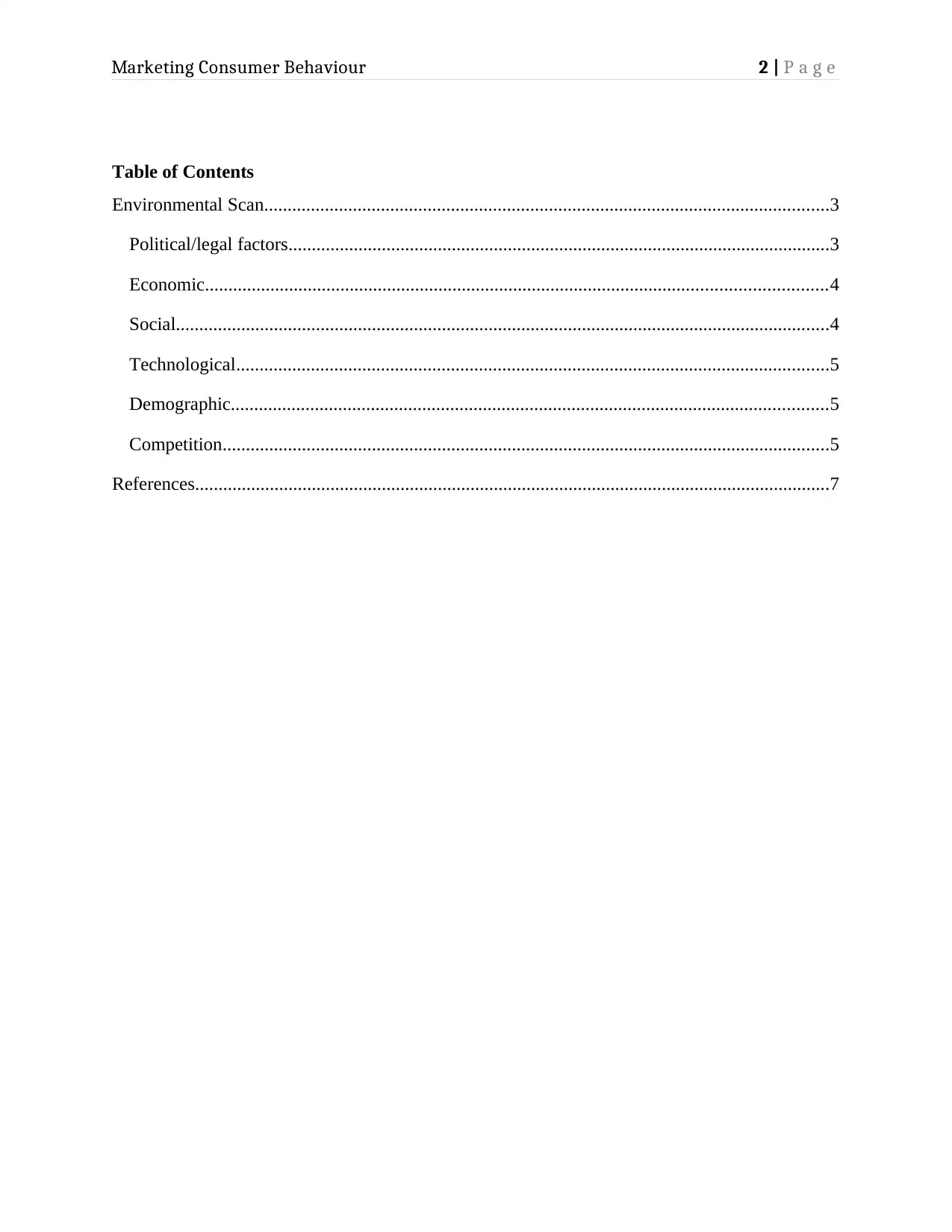
Marketing Consumer Behaviour 2 | P a g e
Table of Contents
Environmental Scan.........................................................................................................................3
Political/legal factors....................................................................................................................3
Economic.....................................................................................................................................4
Social............................................................................................................................................4
Technological...............................................................................................................................5
Demographic................................................................................................................................5
Competition..................................................................................................................................5
References........................................................................................................................................7
Table of Contents
Environmental Scan.........................................................................................................................3
Political/legal factors....................................................................................................................3
Economic.....................................................................................................................................4
Social............................................................................................................................................4
Technological...............................................................................................................................5
Demographic................................................................................................................................5
Competition..................................................................................................................................5
References........................................................................................................................................7
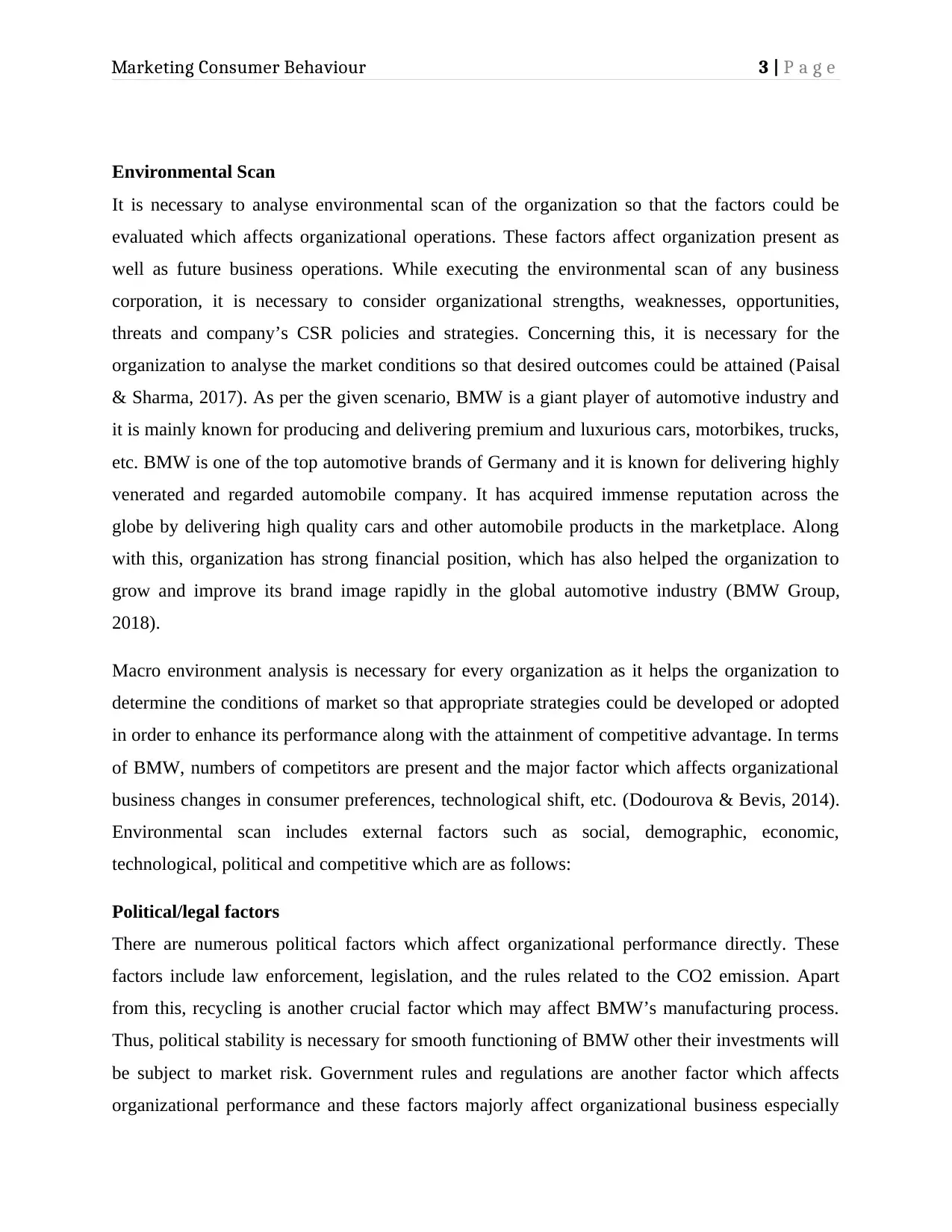
Marketing Consumer Behaviour 3 | P a g e
Environmental Scan
It is necessary to analyse environmental scan of the organization so that the factors could be
evaluated which affects organizational operations. These factors affect organization present as
well as future business operations. While executing the environmental scan of any business
corporation, it is necessary to consider organizational strengths, weaknesses, opportunities,
threats and company’s CSR policies and strategies. Concerning this, it is necessary for the
organization to analyse the market conditions so that desired outcomes could be attained (Paisal
& Sharma, 2017). As per the given scenario, BMW is a giant player of automotive industry and
it is mainly known for producing and delivering premium and luxurious cars, motorbikes, trucks,
etc. BMW is one of the top automotive brands of Germany and it is known for delivering highly
venerated and regarded automobile company. It has acquired immense reputation across the
globe by delivering high quality cars and other automobile products in the marketplace. Along
with this, organization has strong financial position, which has also helped the organization to
grow and improve its brand image rapidly in the global automotive industry (BMW Group,
2018).
Macro environment analysis is necessary for every organization as it helps the organization to
determine the conditions of market so that appropriate strategies could be developed or adopted
in order to enhance its performance along with the attainment of competitive advantage. In terms
of BMW, numbers of competitors are present and the major factor which affects organizational
business changes in consumer preferences, technological shift, etc. (Dodourova & Bevis, 2014).
Environmental scan includes external factors such as social, demographic, economic,
technological, political and competitive which are as follows:
Political/legal factors
There are numerous political factors which affect organizational performance directly. These
factors include law enforcement, legislation, and the rules related to the CO2 emission. Apart
from this, recycling is another crucial factor which may affect BMW’s manufacturing process.
Thus, political stability is necessary for smooth functioning of BMW other their investments will
be subject to market risk. Government rules and regulations are another factor which affects
organizational performance and these factors majorly affect organizational business especially
Environmental Scan
It is necessary to analyse environmental scan of the organization so that the factors could be
evaluated which affects organizational operations. These factors affect organization present as
well as future business operations. While executing the environmental scan of any business
corporation, it is necessary to consider organizational strengths, weaknesses, opportunities,
threats and company’s CSR policies and strategies. Concerning this, it is necessary for the
organization to analyse the market conditions so that desired outcomes could be attained (Paisal
& Sharma, 2017). As per the given scenario, BMW is a giant player of automotive industry and
it is mainly known for producing and delivering premium and luxurious cars, motorbikes, trucks,
etc. BMW is one of the top automotive brands of Germany and it is known for delivering highly
venerated and regarded automobile company. It has acquired immense reputation across the
globe by delivering high quality cars and other automobile products in the marketplace. Along
with this, organization has strong financial position, which has also helped the organization to
grow and improve its brand image rapidly in the global automotive industry (BMW Group,
2018).
Macro environment analysis is necessary for every organization as it helps the organization to
determine the conditions of market so that appropriate strategies could be developed or adopted
in order to enhance its performance along with the attainment of competitive advantage. In terms
of BMW, numbers of competitors are present and the major factor which affects organizational
business changes in consumer preferences, technological shift, etc. (Dodourova & Bevis, 2014).
Environmental scan includes external factors such as social, demographic, economic,
technological, political and competitive which are as follows:
Political/legal factors
There are numerous political factors which affect organizational performance directly. These
factors include law enforcement, legislation, and the rules related to the CO2 emission. Apart
from this, recycling is another crucial factor which may affect BMW’s manufacturing process.
Thus, political stability is necessary for smooth functioning of BMW other their investments will
be subject to market risk. Government rules and regulations are another factor which affects
organizational performance and these factors majorly affect organizational business especially
⊘ This is a preview!⊘
Do you want full access?
Subscribe today to unlock all pages.

Trusted by 1+ million students worldwide
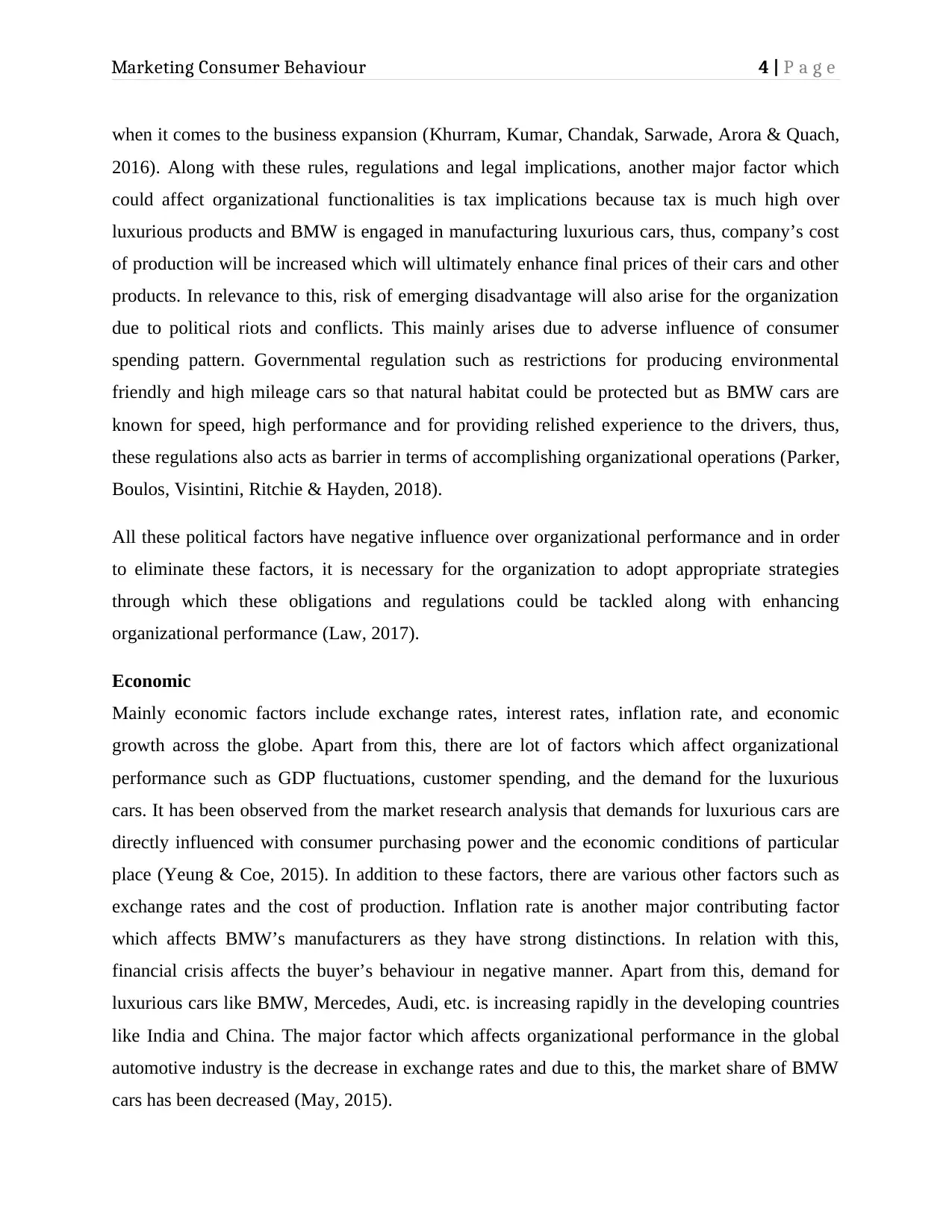
Marketing Consumer Behaviour 4 | P a g e
when it comes to the business expansion (Khurram, Kumar, Chandak, Sarwade, Arora & Quach,
2016). Along with these rules, regulations and legal implications, another major factor which
could affect organizational functionalities is tax implications because tax is much high over
luxurious products and BMW is engaged in manufacturing luxurious cars, thus, company’s cost
of production will be increased which will ultimately enhance final prices of their cars and other
products. In relevance to this, risk of emerging disadvantage will also arise for the organization
due to political riots and conflicts. This mainly arises due to adverse influence of consumer
spending pattern. Governmental regulation such as restrictions for producing environmental
friendly and high mileage cars so that natural habitat could be protected but as BMW cars are
known for speed, high performance and for providing relished experience to the drivers, thus,
these regulations also acts as barrier in terms of accomplishing organizational operations (Parker,
Boulos, Visintini, Ritchie & Hayden, 2018).
All these political factors have negative influence over organizational performance and in order
to eliminate these factors, it is necessary for the organization to adopt appropriate strategies
through which these obligations and regulations could be tackled along with enhancing
organizational performance (Law, 2017).
Economic
Mainly economic factors include exchange rates, interest rates, inflation rate, and economic
growth across the globe. Apart from this, there are lot of factors which affect organizational
performance such as GDP fluctuations, customer spending, and the demand for the luxurious
cars. It has been observed from the market research analysis that demands for luxurious cars are
directly influenced with consumer purchasing power and the economic conditions of particular
place (Yeung & Coe, 2015). In addition to these factors, there are various other factors such as
exchange rates and the cost of production. Inflation rate is another major contributing factor
which affects BMW’s manufacturers as they have strong distinctions. In relation with this,
financial crisis affects the buyer’s behaviour in negative manner. Apart from this, demand for
luxurious cars like BMW, Mercedes, Audi, etc. is increasing rapidly in the developing countries
like India and China. The major factor which affects organizational performance in the global
automotive industry is the decrease in exchange rates and due to this, the market share of BMW
cars has been decreased (May, 2015).
when it comes to the business expansion (Khurram, Kumar, Chandak, Sarwade, Arora & Quach,
2016). Along with these rules, regulations and legal implications, another major factor which
could affect organizational functionalities is tax implications because tax is much high over
luxurious products and BMW is engaged in manufacturing luxurious cars, thus, company’s cost
of production will be increased which will ultimately enhance final prices of their cars and other
products. In relevance to this, risk of emerging disadvantage will also arise for the organization
due to political riots and conflicts. This mainly arises due to adverse influence of consumer
spending pattern. Governmental regulation such as restrictions for producing environmental
friendly and high mileage cars so that natural habitat could be protected but as BMW cars are
known for speed, high performance and for providing relished experience to the drivers, thus,
these regulations also acts as barrier in terms of accomplishing organizational operations (Parker,
Boulos, Visintini, Ritchie & Hayden, 2018).
All these political factors have negative influence over organizational performance and in order
to eliminate these factors, it is necessary for the organization to adopt appropriate strategies
through which these obligations and regulations could be tackled along with enhancing
organizational performance (Law, 2017).
Economic
Mainly economic factors include exchange rates, interest rates, inflation rate, and economic
growth across the globe. Apart from this, there are lot of factors which affect organizational
performance such as GDP fluctuations, customer spending, and the demand for the luxurious
cars. It has been observed from the market research analysis that demands for luxurious cars are
directly influenced with consumer purchasing power and the economic conditions of particular
place (Yeung & Coe, 2015). In addition to these factors, there are various other factors such as
exchange rates and the cost of production. Inflation rate is another major contributing factor
which affects BMW’s manufacturers as they have strong distinctions. In relation with this,
financial crisis affects the buyer’s behaviour in negative manner. Apart from this, demand for
luxurious cars like BMW, Mercedes, Audi, etc. is increasing rapidly in the developing countries
like India and China. The major factor which affects organizational performance in the global
automotive industry is the decrease in exchange rates and due to this, the market share of BMW
cars has been decreased (May, 2015).
Paraphrase This Document
Need a fresh take? Get an instant paraphrase of this document with our AI Paraphraser
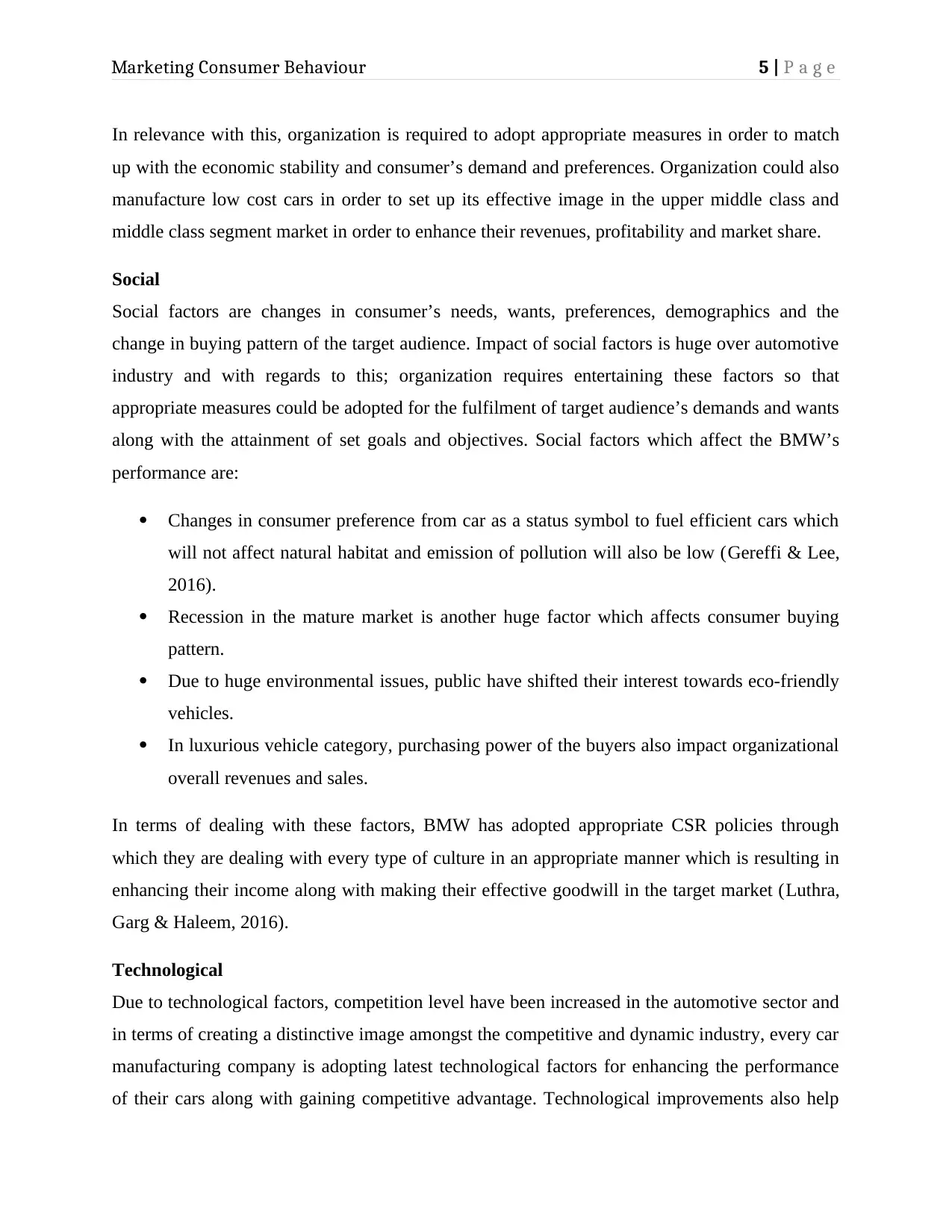
Marketing Consumer Behaviour 5 | P a g e
In relevance with this, organization is required to adopt appropriate measures in order to match
up with the economic stability and consumer’s demand and preferences. Organization could also
manufacture low cost cars in order to set up its effective image in the upper middle class and
middle class segment market in order to enhance their revenues, profitability and market share.
Social
Social factors are changes in consumer’s needs, wants, preferences, demographics and the
change in buying pattern of the target audience. Impact of social factors is huge over automotive
industry and with regards to this; organization requires entertaining these factors so that
appropriate measures could be adopted for the fulfilment of target audience’s demands and wants
along with the attainment of set goals and objectives. Social factors which affect the BMW’s
performance are:
Changes in consumer preference from car as a status symbol to fuel efficient cars which
will not affect natural habitat and emission of pollution will also be low (Gereffi & Lee,
2016).
Recession in the mature market is another huge factor which affects consumer buying
pattern.
Due to huge environmental issues, public have shifted their interest towards eco-friendly
vehicles.
In luxurious vehicle category, purchasing power of the buyers also impact organizational
overall revenues and sales.
In terms of dealing with these factors, BMW has adopted appropriate CSR policies through
which they are dealing with every type of culture in an appropriate manner which is resulting in
enhancing their income along with making their effective goodwill in the target market (Luthra,
Garg & Haleem, 2016).
Technological
Due to technological factors, competition level have been increased in the automotive sector and
in terms of creating a distinctive image amongst the competitive and dynamic industry, every car
manufacturing company is adopting latest technological factors for enhancing the performance
of their cars along with gaining competitive advantage. Technological improvements also help
In relevance with this, organization is required to adopt appropriate measures in order to match
up with the economic stability and consumer’s demand and preferences. Organization could also
manufacture low cost cars in order to set up its effective image in the upper middle class and
middle class segment market in order to enhance their revenues, profitability and market share.
Social
Social factors are changes in consumer’s needs, wants, preferences, demographics and the
change in buying pattern of the target audience. Impact of social factors is huge over automotive
industry and with regards to this; organization requires entertaining these factors so that
appropriate measures could be adopted for the fulfilment of target audience’s demands and wants
along with the attainment of set goals and objectives. Social factors which affect the BMW’s
performance are:
Changes in consumer preference from car as a status symbol to fuel efficient cars which
will not affect natural habitat and emission of pollution will also be low (Gereffi & Lee,
2016).
Recession in the mature market is another huge factor which affects consumer buying
pattern.
Due to huge environmental issues, public have shifted their interest towards eco-friendly
vehicles.
In luxurious vehicle category, purchasing power of the buyers also impact organizational
overall revenues and sales.
In terms of dealing with these factors, BMW has adopted appropriate CSR policies through
which they are dealing with every type of culture in an appropriate manner which is resulting in
enhancing their income along with making their effective goodwill in the target market (Luthra,
Garg & Haleem, 2016).
Technological
Due to technological factors, competition level have been increased in the automotive sector and
in terms of creating a distinctive image amongst the competitive and dynamic industry, every car
manufacturing company is adopting latest technological factors for enhancing the performance
of their cars along with gaining competitive advantage. Technological improvements also help
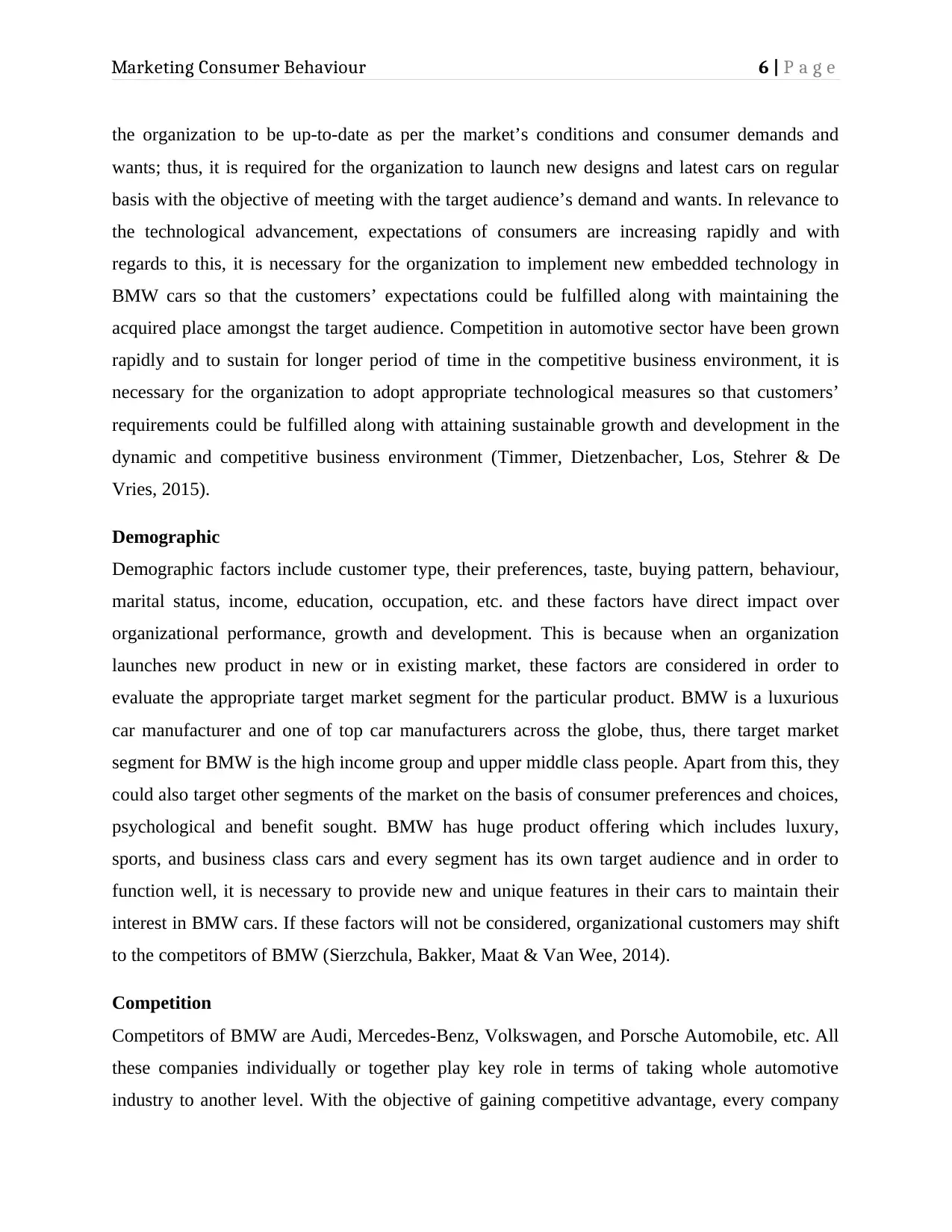
Marketing Consumer Behaviour 6 | P a g e
the organization to be up-to-date as per the market’s conditions and consumer demands and
wants; thus, it is required for the organization to launch new designs and latest cars on regular
basis with the objective of meeting with the target audience’s demand and wants. In relevance to
the technological advancement, expectations of consumers are increasing rapidly and with
regards to this, it is necessary for the organization to implement new embedded technology in
BMW cars so that the customers’ expectations could be fulfilled along with maintaining the
acquired place amongst the target audience. Competition in automotive sector have been grown
rapidly and to sustain for longer period of time in the competitive business environment, it is
necessary for the organization to adopt appropriate technological measures so that customers’
requirements could be fulfilled along with attaining sustainable growth and development in the
dynamic and competitive business environment (Timmer, Dietzenbacher, Los, Stehrer & De
Vries, 2015).
Demographic
Demographic factors include customer type, their preferences, taste, buying pattern, behaviour,
marital status, income, education, occupation, etc. and these factors have direct impact over
organizational performance, growth and development. This is because when an organization
launches new product in new or in existing market, these factors are considered in order to
evaluate the appropriate target market segment for the particular product. BMW is a luxurious
car manufacturer and one of top car manufacturers across the globe, thus, there target market
segment for BMW is the high income group and upper middle class people. Apart from this, they
could also target other segments of the market on the basis of consumer preferences and choices,
psychological and benefit sought. BMW has huge product offering which includes luxury,
sports, and business class cars and every segment has its own target audience and in order to
function well, it is necessary to provide new and unique features in their cars to maintain their
interest in BMW cars. If these factors will not be considered, organizational customers may shift
to the competitors of BMW (Sierzchula, Bakker, Maat & Van Wee, 2014).
Competition
Competitors of BMW are Audi, Mercedes-Benz, Volkswagen, and Porsche Automobile, etc. All
these companies individually or together play key role in terms of taking whole automotive
industry to another level. With the objective of gaining competitive advantage, every company
the organization to be up-to-date as per the market’s conditions and consumer demands and
wants; thus, it is required for the organization to launch new designs and latest cars on regular
basis with the objective of meeting with the target audience’s demand and wants. In relevance to
the technological advancement, expectations of consumers are increasing rapidly and with
regards to this, it is necessary for the organization to implement new embedded technology in
BMW cars so that the customers’ expectations could be fulfilled along with maintaining the
acquired place amongst the target audience. Competition in automotive sector have been grown
rapidly and to sustain for longer period of time in the competitive business environment, it is
necessary for the organization to adopt appropriate technological measures so that customers’
requirements could be fulfilled along with attaining sustainable growth and development in the
dynamic and competitive business environment (Timmer, Dietzenbacher, Los, Stehrer & De
Vries, 2015).
Demographic
Demographic factors include customer type, their preferences, taste, buying pattern, behaviour,
marital status, income, education, occupation, etc. and these factors have direct impact over
organizational performance, growth and development. This is because when an organization
launches new product in new or in existing market, these factors are considered in order to
evaluate the appropriate target market segment for the particular product. BMW is a luxurious
car manufacturer and one of top car manufacturers across the globe, thus, there target market
segment for BMW is the high income group and upper middle class people. Apart from this, they
could also target other segments of the market on the basis of consumer preferences and choices,
psychological and benefit sought. BMW has huge product offering which includes luxury,
sports, and business class cars and every segment has its own target audience and in order to
function well, it is necessary to provide new and unique features in their cars to maintain their
interest in BMW cars. If these factors will not be considered, organizational customers may shift
to the competitors of BMW (Sierzchula, Bakker, Maat & Van Wee, 2014).
Competition
Competitors of BMW are Audi, Mercedes-Benz, Volkswagen, and Porsche Automobile, etc. All
these companies individually or together play key role in terms of taking whole automotive
industry to another level. With the objective of gaining competitive advantage, every company
⊘ This is a preview!⊘
Do you want full access?
Subscribe today to unlock all pages.

Trusted by 1+ million students worldwide
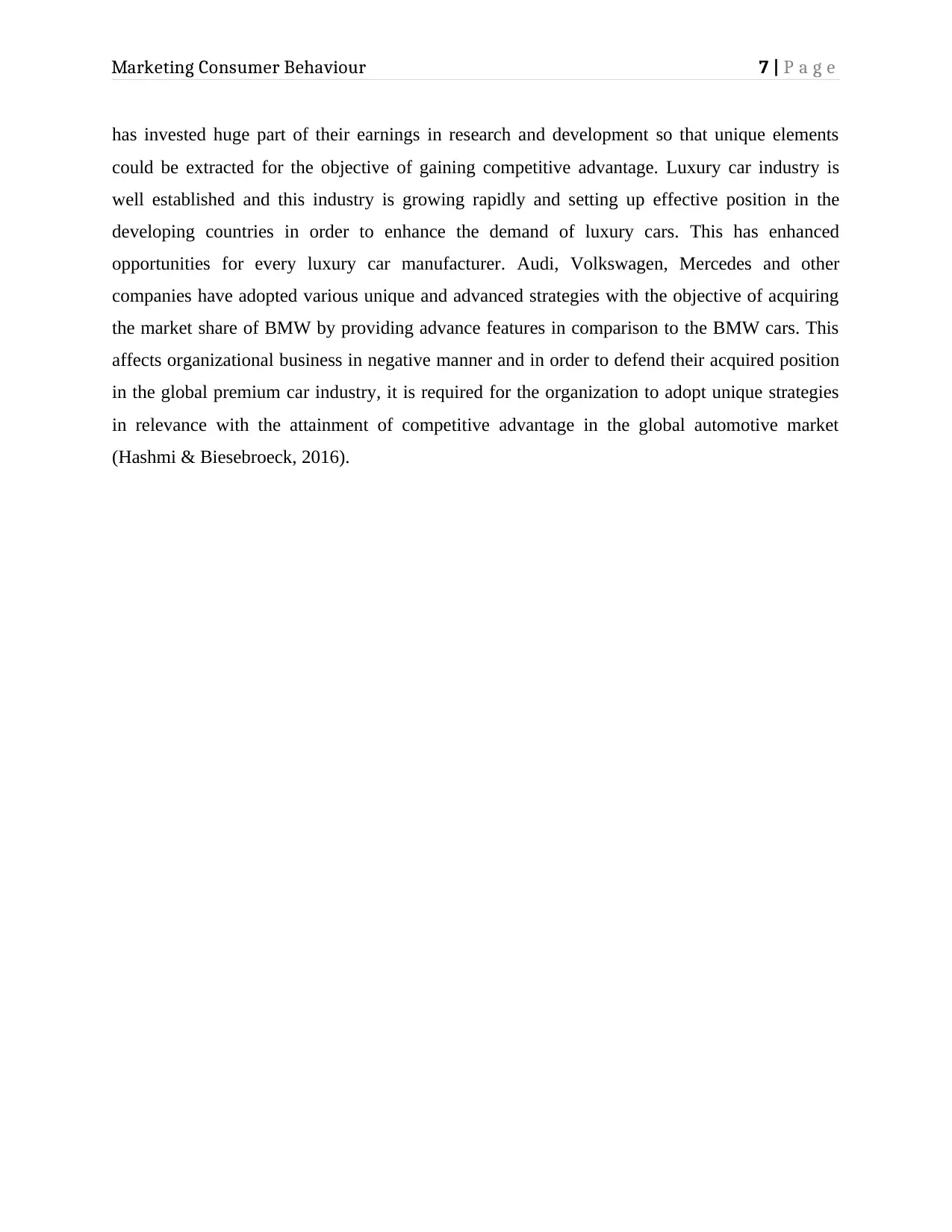
Marketing Consumer Behaviour 7 | P a g e
has invested huge part of their earnings in research and development so that unique elements
could be extracted for the objective of gaining competitive advantage. Luxury car industry is
well established and this industry is growing rapidly and setting up effective position in the
developing countries in order to enhance the demand of luxury cars. This has enhanced
opportunities for every luxury car manufacturer. Audi, Volkswagen, Mercedes and other
companies have adopted various unique and advanced strategies with the objective of acquiring
the market share of BMW by providing advance features in comparison to the BMW cars. This
affects organizational business in negative manner and in order to defend their acquired position
in the global premium car industry, it is required for the organization to adopt unique strategies
in relevance with the attainment of competitive advantage in the global automotive market
(Hashmi & Biesebroeck, 2016).
has invested huge part of their earnings in research and development so that unique elements
could be extracted for the objective of gaining competitive advantage. Luxury car industry is
well established and this industry is growing rapidly and setting up effective position in the
developing countries in order to enhance the demand of luxury cars. This has enhanced
opportunities for every luxury car manufacturer. Audi, Volkswagen, Mercedes and other
companies have adopted various unique and advanced strategies with the objective of acquiring
the market share of BMW by providing advance features in comparison to the BMW cars. This
affects organizational business in negative manner and in order to defend their acquired position
in the global premium car industry, it is required for the organization to adopt unique strategies
in relevance with the attainment of competitive advantage in the global automotive market
(Hashmi & Biesebroeck, 2016).
Paraphrase This Document
Need a fresh take? Get an instant paraphrase of this document with our AI Paraphraser
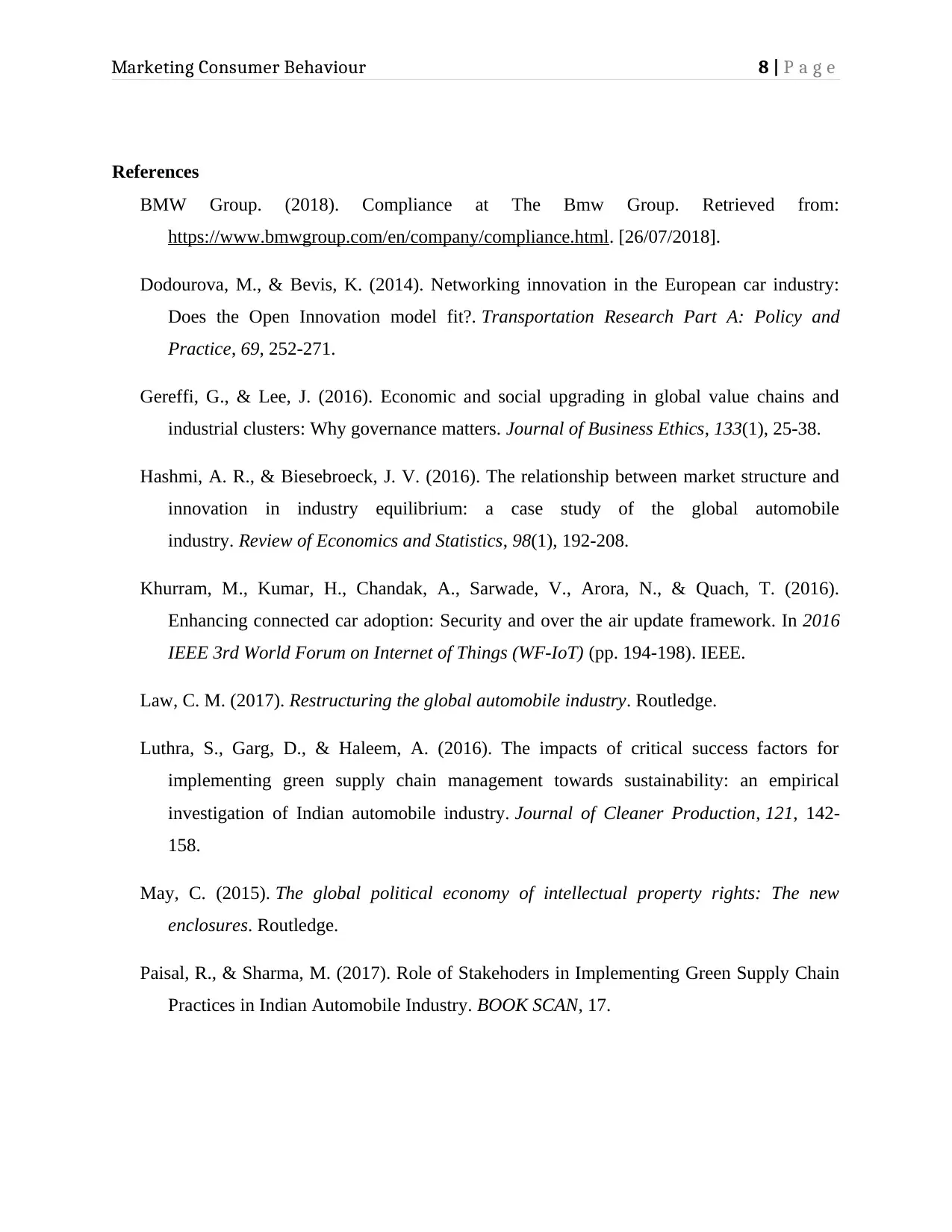
Marketing Consumer Behaviour 8 | P a g e
References
BMW Group. (2018). Compliance at The Bmw Group. Retrieved from:
https://www.bmwgroup.com/en/company/compliance.html. [26/07/2018].
Dodourova, M., & Bevis, K. (2014). Networking innovation in the European car industry:
Does the Open Innovation model fit?. Transportation Research Part A: Policy and
Practice, 69, 252-271.
Gereffi, G., & Lee, J. (2016). Economic and social upgrading in global value chains and
industrial clusters: Why governance matters. Journal of Business Ethics, 133(1), 25-38.
Hashmi, A. R., & Biesebroeck, J. V. (2016). The relationship between market structure and
innovation in industry equilibrium: a case study of the global automobile
industry. Review of Economics and Statistics, 98(1), 192-208.
Khurram, M., Kumar, H., Chandak, A., Sarwade, V., Arora, N., & Quach, T. (2016).
Enhancing connected car adoption: Security and over the air update framework. In 2016
IEEE 3rd World Forum on Internet of Things (WF-IoT) (pp. 194-198). IEEE.
Law, C. M. (2017). Restructuring the global automobile industry. Routledge.
Luthra, S., Garg, D., & Haleem, A. (2016). The impacts of critical success factors for
implementing green supply chain management towards sustainability: an empirical
investigation of Indian automobile industry. Journal of Cleaner Production, 121, 142-
158.
May, C. (2015). The global political economy of intellectual property rights: The new
enclosures. Routledge.
Paisal, R., & Sharma, M. (2017). Role of Stakehoders in Implementing Green Supply Chain
Practices in Indian Automobile Industry. BOOK SCAN, 17.
References
BMW Group. (2018). Compliance at The Bmw Group. Retrieved from:
https://www.bmwgroup.com/en/company/compliance.html. [26/07/2018].
Dodourova, M., & Bevis, K. (2014). Networking innovation in the European car industry:
Does the Open Innovation model fit?. Transportation Research Part A: Policy and
Practice, 69, 252-271.
Gereffi, G., & Lee, J. (2016). Economic and social upgrading in global value chains and
industrial clusters: Why governance matters. Journal of Business Ethics, 133(1), 25-38.
Hashmi, A. R., & Biesebroeck, J. V. (2016). The relationship between market structure and
innovation in industry equilibrium: a case study of the global automobile
industry. Review of Economics and Statistics, 98(1), 192-208.
Khurram, M., Kumar, H., Chandak, A., Sarwade, V., Arora, N., & Quach, T. (2016).
Enhancing connected car adoption: Security and over the air update framework. In 2016
IEEE 3rd World Forum on Internet of Things (WF-IoT) (pp. 194-198). IEEE.
Law, C. M. (2017). Restructuring the global automobile industry. Routledge.
Luthra, S., Garg, D., & Haleem, A. (2016). The impacts of critical success factors for
implementing green supply chain management towards sustainability: an empirical
investigation of Indian automobile industry. Journal of Cleaner Production, 121, 142-
158.
May, C. (2015). The global political economy of intellectual property rights: The new
enclosures. Routledge.
Paisal, R., & Sharma, M. (2017). Role of Stakehoders in Implementing Green Supply Chain
Practices in Indian Automobile Industry. BOOK SCAN, 17.
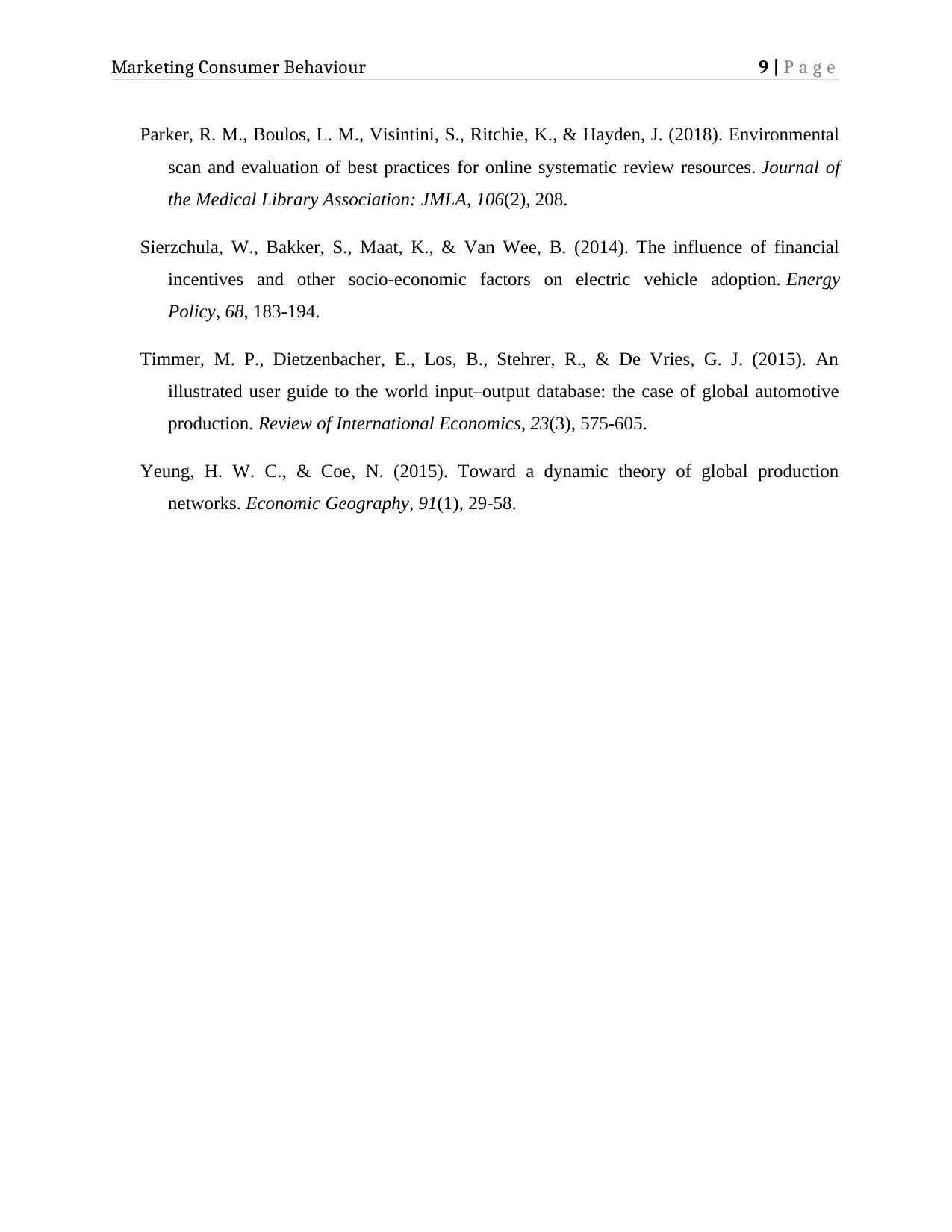
Marketing Consumer Behaviour 9 | P a g e
Parker, R. M., Boulos, L. M., Visintini, S., Ritchie, K., & Hayden, J. (2018). Environmental
scan and evaluation of best practices for online systematic review resources. Journal of
the Medical Library Association: JMLA, 106(2), 208.
Sierzchula, W., Bakker, S., Maat, K., & Van Wee, B. (2014). The influence of financial
incentives and other socio-economic factors on electric vehicle adoption. Energy
Policy, 68, 183-194.
Timmer, M. P., Dietzenbacher, E., Los, B., Stehrer, R., & De Vries, G. J. (2015). An
illustrated user guide to the world input–output database: the case of global automotive
production. Review of International Economics, 23(3), 575-605.
Yeung, H. W. C., & Coe, N. (2015). Toward a dynamic theory of global production
networks. Economic Geography, 91(1), 29-58.
Parker, R. M., Boulos, L. M., Visintini, S., Ritchie, K., & Hayden, J. (2018). Environmental
scan and evaluation of best practices for online systematic review resources. Journal of
the Medical Library Association: JMLA, 106(2), 208.
Sierzchula, W., Bakker, S., Maat, K., & Van Wee, B. (2014). The influence of financial
incentives and other socio-economic factors on electric vehicle adoption. Energy
Policy, 68, 183-194.
Timmer, M. P., Dietzenbacher, E., Los, B., Stehrer, R., & De Vries, G. J. (2015). An
illustrated user guide to the world input–output database: the case of global automotive
production. Review of International Economics, 23(3), 575-605.
Yeung, H. W. C., & Coe, N. (2015). Toward a dynamic theory of global production
networks. Economic Geography, 91(1), 29-58.
⊘ This is a preview!⊘
Do you want full access?
Subscribe today to unlock all pages.

Trusted by 1+ million students worldwide
1 out of 9
Related Documents
Your All-in-One AI-Powered Toolkit for Academic Success.
+13062052269
info@desklib.com
Available 24*7 on WhatsApp / Email
![[object Object]](/_next/static/media/star-bottom.7253800d.svg)
Unlock your academic potential
Copyright © 2020–2025 A2Z Services. All Rights Reserved. Developed and managed by ZUCOL.



